Round Up: Five Powerful, Light Ultraportables
Lenovo Ideapad U110: Style and Usability
Style
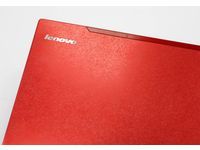
Have you ever seen a ThinkPad? If so, you know how Lenovo (nee IBM) defines style: black, drab, and utilitarian. But if the ThinkPad line is the corporate drone of mobile computing, the IdeaPad line is the entrepreneurial artiste, and the IdeaPad U110—the smallest and most stylish IdeaPad to date—is the quick-witted fashionista. You need only glance at the U110’s closed lid for a first impression of the design theme here: delicate, spiraling, floral, shimmering, yet subtle "tendrils" (Lenovo’s word, not mine). Before we go any further, I’ll simply express my belief that the U110’s crimson runic patterns will more likely appeal to women than men. That’s not based on a survey, but the odds are in my favor. Red is not among my favorite colors—the unit also comes in black and navy blue—but I adore this computer’s style cues; you may not.


The pattern on the lightly textured (etched) lid, with the darker solid-stripe lip and silver reflective Lenovo branding, repeats itself twice more on this computer. Before opening it, flip it over and notice a gray-on-black version of the tendrils, nearly invisible on the lower left corner of the underside.


Also on the flip side are other exotic-looking patterns carved into the plastic in a scattered fashion—these are somewhat functional, revealing vents that allow heat to escape. The final iteration of the tendrils can be found on the inside, at the top of the keyboard where the chassis meets the screen hinge. We’ll get to this more later on, but a finger swipe across a patch of seemingly empty black plastic reveals red-lit subcutaneous LEDs in the shape of curlicue tendrils that can serve as multimedia buttons.


The last style-oriented feature of the U110 is the abundant use of the currently trendy shiny piano black lacquer on the inside—the flat screen-bezel, the keyboard, wristpad, trackpad and buttons are all coated in the slimy stuff. It feels great to the touch, but if you don’t apply the included chamois every ten minutes during use, the chassis starts to look dull and icky. The sides, battery and bottom of the computer are rubberized instead of lacquered, which makes the machine easy to grip.
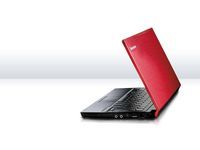
Even though it is, overall, the smallest machine in this roundup in terms of size (not thickness or weight), the U110 is hearty. The lid is very solid, and as noted earlier, the bottom is ruggedized with rubber (though the little feet on the bottom can sometimes seem a bit slippery on a flat surface). The lid is actually bent at about a 130 degree angle at the last inch closest to the hinge. This bent portion of the metal offsets the screen from the hinge, and strengthens the hinge, which seems to improve viewing angles. Like the Asus U2E, the lip of the lid has no hinge—it stays shut solely via pressure from the hinge.
Lenovo even includes a leather carrying case for the U110—this machine is just that fancy.
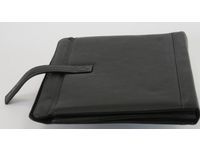
Size and Weight
Stay on the Cutting Edge
Join the experts who read Tom's Hardware for the inside track on enthusiast PC tech news — and have for over 25 years. We'll send breaking news and in-depth reviews of CPUs, GPUs, AI, maker hardware and more straight to your inbox.
The larger of the two batteries that come with this computer protrudes only slightly from the rear; its curved shape adds to the compact form factor of the machine. The unit’s dimensions are 10.8” wide by 7.7” deep, and 0.88” thick, which is thinner than the Apple MacBook Air. The smaller battery sticks out even less; here you can see the difference:


The U110 weighs only 2.4 pounds, but doesn’t include a built-in optical drive; a solid, rubberized black and perforated-metal external drive is included. The Toshiba Portege R500, while a good deal wider than the Lenovo, includes an internal optical drive and maintains the same weight and thickness as the U110. The power supply brick is a featherweight at 0.67 lbs.
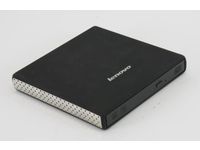
Will you miss the internal optical drive? I didn’t, but I didn’t take any long distance flights while testing it. DVD entertainment is the only crucial use of an optical drive I can think of; I can’t ding the U110 too much for leaving it out.
Ports

Switching FireWire for HDMI/Micro-DVI, the U110 has a very similar port configuration to that of the Asus U2E. On the left hand side, the computer has a power port, VGA port, angled fan, two USB ports, and at the edge, a Wi-Fi on/off switch. Along the front bottom lip, Lenovo has placed nothing but a glowing blue LED icon in the shape of a power button, to indicate the computer’s status.
On the right hand side there is an ExpressCard slot, an SD (and other format) card reader, a headphone and microphone jack, Firewire port, one final USB port, and a gigabit Ethernet port. There’s no modem, and there’s no internal broadband card—use the ExpressCard slot to get either function if necessary. Speaking of wireless communications, the Lenovo meets all the usual standards except Draft-N. It’s the only one in this roundup to lack N compliance, but perhaps is has been left out because very few consumer router and products actually feature N, and this is a very consumer-friendly machine.


Style score: 5
Usability
Display

In terms of specifications, the U110’s 11.1” screen is identical to the Asus U2E’s—it’s an LED backlit glossy number. But something about the Lenovo’s is just glossier. When I stare into the screen for a while, it seems to be a bit distorted by an extra layer of glass, and the content of the screen looks shimmery and textured; there’s also some glare and distortion. Color vibrancy is spot on, however. The entire display piece—the underside of the lid—is completely smooth, as though made from one piece of plastic, with the exception of the small notch in the top center for the tiny webcam.
Keyboard
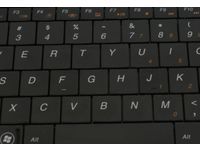
Each key on the smudgy piano black keyboard of the U110 is big—bigger than any key on almost any other ultraportable—but size alone does not a comfortable keyboard make. Each key depresses smoothly and evenly, too, but that also is not enough. For a keyboard to be efficient, it needs to maintain a typist’s speed and keep the error rate low. This keyboard decreased my speed and increased my error rate because of the lack of space between the keys, which are practically flush against each other. They are also completely flat, which means there is no texture or shape, other than a slight concavity, to teach my fingers where each key is. More often than not, I hit a neighboring key by accident because each key is so flat and slick. I didn’t live with this computer for months, and if I did I would surely adapt to its quirks, but why should a keyboard force a user to deal with a steep learning curve?
Trackpad

The U110’s trackpad is perfectly smooth and matte—it doesn’t have quite the same lacquering as the rest of the chassis, but it does have a little. It is very responsible and slick, and the seam between the trackpad and wristpad is obvious without feeling jarring when you reach it with your finger. The mouse buttons are similar, but received the full piano black paint job. They’re even, only slightly raised from the trackpad, and not too springy when clicked. Some people might prefer a bit more response from the buttons, though.
Hardware Controls

The "magical" swiping action that activates scrolling the soft keys above the keyboard is one the most whimsical and cutting-edge features of this computer. It might seem inefficient to have buttons that aren’t always visible, but how many people even set up the physical multimedia buttons that grace a typical laptop? One of the buttons launches an audio manager, and two of the other buttons can be tied to a macro that activates just about any other application. There’s also a visible volume control light (up, down and mute). On the left side there is a power button and a "Novo" button. This latter button performs many tasks: generally, clicking it activates power settings to conserve battery life. But if something’s amiss with the machine, clicking it when the computer’s off can activate a system restore the next time the machine is powered on (let’s hope you never have to use it!) Behind these keys are the small "Dolby Home Theater" speakers, one on each side. Perhaps they produce better than average external sound, but it’s still nothing to write home about.
Heat and Noise
I never felt this machine get warmer than room temperature, nor make any noise at all. That’s surprising given the U110 has a weak hard drive (only running at 4,200 RPM), though the processor never seemed to struggle with any typical tasks, except perhaps upon startup, which took an above average of 90 seconds. I also lost a bit of time every time the facial-recognition software popped up when starting; it works, but steals at least 15 seconds every time you open up the machine. Remember, this is a consumer machine, and it does media well—better than most of its suit-and-tie ultraportable competitors. Check out the Performance section below for more details.
Usability score: 3
Current page: Lenovo Ideapad U110: Style and Usability
Prev Page Asus U2E-AIB: Price, Battery, Performance Next Page Lenovo Ideapad U110: Price, Battery, Performance-
these are all at the high-end of the price spectrum, have you considered the asus eee pc or acer aspire one? i have one of these, and while it's not exactly a gaming powerhouse it does all you need in a small laptop... mind you the linux distros these things come with can be a real painReply
-
JJeng1 A possible reason for the fingerprint reader placement. Look into the options of the fingerprint software, as sometimes the reader doubles as a scroll wheel.Reply -
Regulas Rubbish, get the the new Macbook, 13" screen plenty of power no viruses and no bloated Vista for the low end of cash stated in this review.Reply -
bjornlo ReplyRubbish, get the the new Macbook, 13" screen plenty of power no viruses and no bloated Vista for the low end of cash stated in this review.
Typical ignorant fanboi BS.
Get your facts straight. Nothing wrong with a Mac other than total cost of ownership and slightly reduced software choices... although the default browser is very unsecure (but fixable, DL any other). But, there is nothing special about them except their style and slightly better ease of use for the "technologically challenged". -
Placebo First of, Macs are rubbish. Buying one is alright for the creative crowd, whose fav. software is exclusive for OSX. Other than that, the company would have already closed up, if not saved by the mighty (LOL) Ipod-brand.Reply
Regarding the otherwise brilliant review, how come the Dell M1330 isn't mentioned, or even tested, its not even on the site?!?!
Best selling product in the category for almost two years. Anyone buying should look into it. Had one for around a year, can honestly say its the best electronic device i ever owned.
Its cheap, lightwight and with supurb spec!
www.notebookreview.com for notebooks :-)Sry... they jus do a better job.
-
boostercorp i guess i never understood why you'd need such a small underpowered laptop and also never knew who would buy such a thing.Reply
But if you're on the road alot like me it would be more handy then dragging around a 8 pound 17" laptop like i 'm currently doing.
i only hoped they'd be a little less expensive cause i bought my 17" for € 899 and got a shedload of stuff i didn't need like that fingerprint scanner ,bluetooth ,ir , ... -
Can we post a review of ultraportables with eSATA and Express Card ? I think the ASUS U6V (not sure) has one, the Dell E4200 and E4300 have eSATA but no Express Card. The Lenovo X200 and X300 series have some great features. I really hope manufacturers start making machines with eSATA and Express Card and not one or the other. Oh and How about the Toshiba dynabook R6 ?Reply
-
enforcer22 "Rubbish, get the the new Macbook, 13" screen plenty of power no viruses and no bloated Vista for the low end of cash stated in this review."Reply
O your right and look i cant do anything i want to do with it either.. I also cant get it to look like a computer instead of a over priced pos paperweight. Linux is as usless to me as that over priced thing keeping my desk up to.
Most Popular

